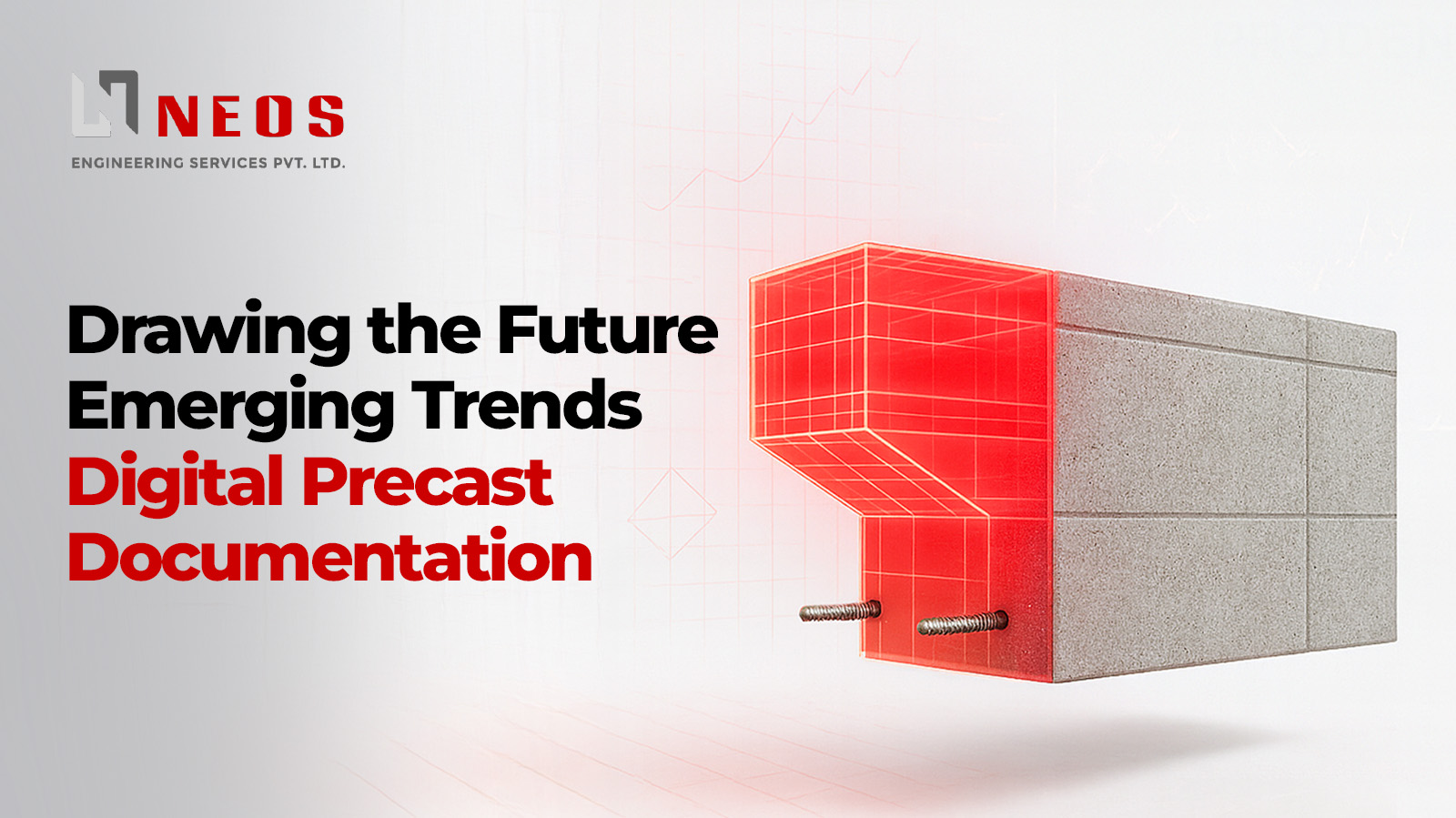
In the world of construction, the foundation of success is often drawn long before a single concrete element is cast. Precast detailing, in particular, has evolved from being a simple representation of design intent into a sophisticated communication tool that connects every stage of a project. At NEOS, experience across diverse projects and regions has highlighted one central truth: the future of precast success depends not only on accurate drawings, but on how effectively information flows from design to fabrication, transport, and installation.
From Drawings to Data
Precast documentation is moving beyond static two-dimensional sheets. Modern drawings are no longer just visual representations; they are dynamic sources of information. Every line, section, and note can carry embedded data for material quantities, lifting points, production scheduling, and traceability. A single section detail is no longer just about showing reinforcement; it communicates material type, casting sequence, and handling requirements.
This shift transforms drawings into a bridge between design and logistics. Fabricators, transport coordinators, and site engineers can all access the same information simultaneously, ensuring that every decision is informed and every step aligns with the intended plan. The boundaries between design, production, and execution are dissolving, and digital documentation is leading the way.
Instant Constructability Feedback
One of the most critical challenges in precast construction has always been discovering conflicts too late. Lifting clashes, connection issues, or tolerance problems often emerge on-site, causing delays, additional costs, and increased risk.
The next generation of precast documentation integrates rule-based checks and constructability assessments within the drawing itself. Potential conflicts are flagged early, long before production begins. At NEOS, this approach has been adopted as standard practice. Every element is reviewed not just for dimensional accuracy but also from fabrication, lifting, and erection perspectives. The result is fewer surprises, smoother workflows, and a reduction in costly revisions.One of the most critical challenges in precast construction has always been discovering conflicts too late. Lifting clashes, connection issues, or tolerance problems often emerge on-site, causing delays, additional costs, and increased risk.
The next generation of precast documentation integrates rule-based checks and constructability assessments within the drawing itself. Potential conflicts are flagged early, long before production begins. At NEOS, this approach has been adopted as standard practice. Every element is reviewed not just for dimensional accuracy but also from fabrication, lifting, and erection perspectives. The result is fewer surprises, smoother workflows, and a reduction in costly revisions.
Visual Communication as Quality Assurance
Clarity in drawings is as important as precision. As projects grow in scale and complexity, stakeholders require documentation that communicates intent effectively and instantly. Drawings must guide the viewer from concept to action, making it easy to understand sequences, connections, and critical details.
At NEOS, visual communication is treated as a measurable aspect of quality. Every drawing is reviewed for layout, note hierarchy, and readability. Symbols and annotations follow consistent conventions, allowing teams to interpret them without delay or confusion. This ensures that both on-site teams and off-site coordinators can execute work confidently, knowing that the drawing reflects reality accurately.
Sustainability Through Smart Detailing
Intelligent planning is the first step toward sustainable construction. Precast documentation that anticipates real-world constraints helps optimize material usage, minimize waste, and reduce transport inefficiencies. By coordinating every element virtually, fewer errors occur on-site, leading to fewer corrections, fewer material losses, and more efficient use of resources.
This approach highlights a quiet but significant contribution to greener construction. Thoughtfully detailed drawings reduce unnecessary concrete use, prevent redundant handling, and enable more predictable and efficient delivery schedules. Sustainability is no longer a separate consideration; it is embedded within the documentation process itself.
The Human-Digital Balance
Even as technology advances, human expertise remains indispensable. Software and digital tools can process vast amounts of data, generate drawings quickly, and flag potential clashes. Yet experience, intuition, and practical knowledge of site conditions cannot be automated. Successful precast detailing combines digital precision with the insight of seasoned engineers.
NEOS exemplifies this balance by using advanced modeling tools alongside human judgment. Every decision, from reinforcement placement to lifting orientation, is informed by real-world understanding. This ensures that digital outputs are not just technically correct but also buildable, practical, and efficient. The future of precast documentation will belong to those who master this synergy of human and digital capabilities.
Drawing Tomorrow, Today
At NEOS, drawings are more than records; they are the starting point for execution. Every sheet carries foresight, accuracy, and practical guidance, transforming design intent into actionable steps. Precast elements are visualized through their entire lifecycle — from casting to transport and installation.
This philosophy ensures that projects move smoothly and efficiently. Contractors and site teams receive drawings that anticipate challenges, minimize errors, and reduce the need for clarifications. The result is accelerated timelines, fewer disputes, and improved overall project quality.
The future of precast construction is being drawn today. NEOS continues to pioneer practices that integrate data, clarity, constructability, sustainability, and human expertise into every document produced. This approach guarantees that drawings are not just tools but strategic enablers of project success.
Every line drawn today sets the stage for smarter, faster, and more sustainable construction tomorrow. In precast detailing, progress does not start at the site; it starts in the planning, in the details, and in the hands of those who understand the art of translating drawings into reality. At NEOS, every drawing is a step toward a future where every precast project is executed efficiently, accurately, and with confidence.
